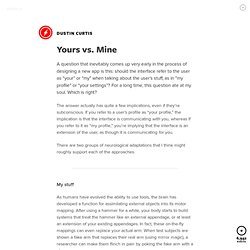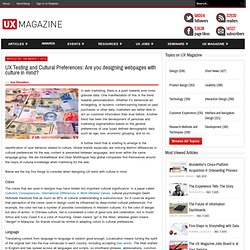

Frictionless Design Choices. No one wants friction in their products.

Everyone works to reduce it. Yours vs. Mine. A question that inevitably comes up very early in the process of designing a new app is this: should the interface refer to the user as “your” or “my” when talking about the user’s stuff, as in “my profile” or “your settings”?

For a long time, this question ate at my soul. Which is right? The answer actually has quite a few implications, even if they’re subconscious. The Ten Golden Principles For Successful Web Apps. Semantic Foundry » The UX Canon: Essential Reading for the User Experience Designer. The Dominant Colors of Common Website Qualities.
By anthony on 07/26/12 at 2:30 pm Choosing colors for your website is no easy task.

With so many colors and color combinations to choose from, where does a designer begin? The color of your site is important because it influences how users feel about your site. Choose the wrong color, and you’ll repel users from your site. Personality. We use web browsers every day and don’t really think about them until something goes wrong.

Google Chrome crashed on me the other day and I got the iconic “Aw, Snap!” Page with the unhappy folder icon. Instead of being cross at the error, it made me smile, and I was more forgiving of the browser for crashing. This is an example of how personality can engage customers’ emotions and help them build a stronger relationship with your brand. While predictability, efficiency, and convenience are assumed for worthwhile product or service experiences in today's market, just being 'useful' is no longer sufficient.
Why Personality Matters A strong personality differentiates a brand’s products or services, especially in globally competitive markets.1 It has long been accepted that customers don't choose products based on their features alone, but also base their selections on symbolic value. A strong personality is particularly important for challengers. What is Brand Personality? Focus on the right-hand side. UX Testing and Cultural Preferences. In web marketing, there is a push towards ever more granular data.

One manifestation of this is the trend towards personalization. Whether it’s behavioral ad re-targeting, or dynamic content-serving based on past purchases or other data, marketers are better able to act on customer information than ever before. Another trend has been the development of personas and marketing segmentation based on the general preferences of user types defined demographic data such as age, sex, economic grouping, and so on. A further trend that is starting to emerge is the identification of user behavior related to culture. Global brands especially are noticing distinct differences in cultural preferences for the way content is presented between languages, and even within the same language group.
Below are the top five things to consider when designing UX tests with culture in mind. Colors The colors that are used in designs may have hidden but important cultural significance. Language High and Low Context. Jennifer Preece - Interaction Design. Interaction Design: Beyond Human Computer Interactionby Jennifer Preece Preece, J., Rogers, Y., & Sharp, H.. (2002).

Interaction Design: Beyond Human-Computer Interaction. A typical undergraduate level textbook to introduce you to the field, including both scientific background and usability design methods. Articles, Demos & Blog » Designing for human behaviour -the top 10 things you need to know about people. (Notes from the UK Usability Professionals’ Association workshop with Dr Susan Weinschenk) We often attend events and network with other experts in the usability and user experience profession.

I recently attended a workshop organised through the UK Usability Professionals’ Association and thought it would be useful to share my notes. In this workshop Susan Weinschenk (a well-known consultant and author from the US) presented her ten principles for engagement. These principles are a really nice summary of considerations that we consider every day when designing interactive experiences. Ten key principles to keep in mind when designing for humans to create positive engagement: Blog.objectivedigital. I’ve reset nine different passwords for various websites and services in the last 3 months; that’s almost one a week.
Resetting passwords is starting to be a regular part of my user experience. Everything requires a login and a password these days and although I have a password system, it breaks down a lot and I have to go around the reset loop. This often makes a quick task on a website I don’t use much a longer process. The Ultimate Guide to Golden Ratio Typography. Why External Links Should Open in New Tabs. By anthony on 01/31/12 at 12:52 pm When most designers design websites, they don’t pay much attention to links. As long as the link works and takes users to the right page, everything is fine. However, a great user experience goes further than that.
Mission Transition. Advertisement Life and nature are one big transition.

The sun slowly rises to mark a new day and then slowly sets to mark the end of the day and the beginning of night. We are created in the womb and from small cells we grow, are born and gradually age until we die. Perhaps these natural transitions in life are what make artificial transitions feel… well, right.